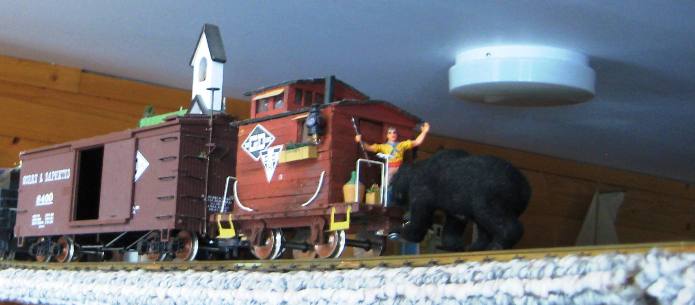 My
Model Railways and the Men Who Inspired Them My
Model Railways and the Men Who Inspired Them
Tales From
the Past
My father told me once that when I was born, he decided to build
model trains so that, when I was older, we would have something
we could do together. That was a pretty progressive concept back
at the beginning of World War II. In the early 1940's, he scratch-built an HO
Scale CPR 4-6-4 Hudson, entirely in brass. The only commercial
parts were the drivers, tender trucks, motor, and gears.
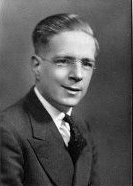  My father, c. 1940 My father, c. 1940
Over
the years, he built a kit or two (or three) each year and
eventually we had an 8 x 12 foot table top railway to run them
on. Locomotives and passenger cars, and some of the freight
cars, were painted for the CPR; other freight cars were for
various Eastern roads. Most of these survived into the late
1980's. I inherited some of them, including the original 4-6-4.
Sadly they were lost in a house fire in 2001.
Before I was old enough to contribute to this, my brother and I
had some Ives and Lionel hi-rail O Gauge trains on the floor.
Good stuff and great fun. These were treasured into our early teens,
and finally they ended up donated to our younger cousins.
By age 11 or 12, I was building freight cars and later kit bashed
an Ambroid coach into an 1890's CPR "dome" car with two
observation cupolas for sightseeing through the Canadian
Rockies. These cars really did exist!

This is Kemtron's CPR 4-6-4 #2459 from the 1970's, a close
cousin to my father's scratch-built CPR #2410, built in the
early 1940's.
By the 1970's, all my father's rolling stock was
in boxes, with only a few on display, including both of the CPR
4-6-4 locomotives and some beautifully built Ambroid and LaBelle
kits.
 MY
FIRST RYE, RUM and REDEYE RAILROAD MY
FIRST RYE, RUM and REDEYE RAILROAD
By the mid-1950's, we
had moved to a house with bedrooms big enough for me to build a
small HO railway of my own. Father's filled the basement and we still
worked on it together. The bedroom layout was the classic oval on a 2
x 6 foot table top. There were two sidings, three industries, a station, and
even a small turntable for the PennLine 0-4-0 diesel. The Rye,
Rum, and Redeye Railroad (RR&R RR) had two passenger cars (with
cardboard sides), a boxcar, tank car, and a caboose. I built a
brass half-length Budd Rail Diesel Car (an RDC-1/2),
had it chrome plated, and it ran fine on the 11 inch radius
curves. Another brass project was a futuristic center cab
diesel. Both were lost in the 2001 house fire - neither were
especially detailed or attractive models so maybe their loss was
a good thing.
This is
where I learned to model scenery, roads, and the usual clutter of
real life. Track was hand laid code100 brass with spikes in every
tie and hand built switches with live frogs. My buildings were
pretty crude and lacked detail. I had more fun with the scenery,
trying to mimic the concepts of John Allen and Jack Work. I
never reached those exalted heights, of course, but their
inspiration got me past the bare table-top.
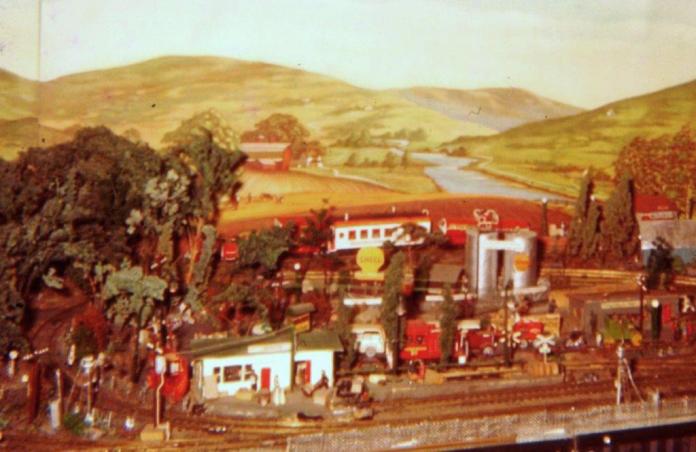
A late 1950's photo of the
RR&R RR in my bedroom. Redeye Station is in the left foreground,
the Shell Oil tank farm is in the middle, a warehouse is at the
right and the distillery is off-screen far-right. The red
Pennline diesel switcher is in front of the tank farm. Handmade
trees, made from paint-dipped weeds, hide a lot of the photo. A
well trafficked road runs across the center to the right, with
Matchbox HO Scale trucks and cars. A small river (creek??) runs
front to back and a nicely printed backdrop gives a little sense
of distance.
Some of the best of John Allen's work can be found
in a hardcover
book by Linn Westcott, republished by
Benchmark Press. 

These are HO Scale standard
gauge cars. I found G&D boxcar #98 at a flea market; it uses
cardboard car sides printed in an NMRA Bulletin. The two G&D
bobbers #3 and #5 are recent NMRA Heritage cars. MDC/Roundhouse
issued a number of HO G&D models, still sought after by
collectors.
The 1st Rye, Rum and Redeye Railroad was abandoned in 1962 when
I moved west to take a job in the oilfields of Western Canada.
 MY
second RYE, RUM and REDEYE RAILROAD MY
second RYE, RUM and REDEYE RAILROAD
During my University
years, I built a very small narrow gauge (HOn3) model railway.
It was only 18 x 24 inches with rugged scenery made from real
red sandstone rocks. The oval dipped into a tunnel under the
mountain. There was one siding with a switchback to a mine. The
station was on the level part of the mainline. Track was
hand laid code 70 nickel-silver with hand made stub switches.
Decent ballast, a few trees, and a few people complimented the
rugged scene. Never got around to building an ore car for the
mine.
The grades were
steep but the Shay could haul a log buggy, flat car, and bobber
caboose. The 0-4-0T steamer could not, so I converted a white metal combine into an
extremely short car and added an N scale diesel power-train to
it, after re-gauging the wheels. This pair ran the grades
just fine. I still have the combine and two 0-4-0T locomotives, all
of them now 60+ years old. The Shay and other rolling stock were
lost in transit, somewhere??
There was a wonderful photo of this
railway with my brothers pet iguana doing his Godzilla act while roaming the rails. No one
can find a copy so let your imagination run wild.
After 13 moves in the first 4 years
of my working career, the railway disintegrated and was
abandoned in 1967.

These are the remnants of my second RR&R RR, an HO Scale narrow
gauge miniature railway. The combine and
two
0-4-0T switchers (one with
coal bunker on the roof) are on display in my
home-office. The Shay, bobber caboose, and log buggy disappeared many
years ago. I could see well enough to do a decent paint job in
those days. Alas, HOn3 is not my strong suit any more -- to see
what came next, scroll on down.
 MY
Rocky mountain house, nordegg and pacific RAILWAY MY
Rocky mountain house, nordegg and pacific RAILWAY
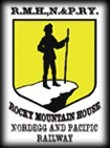 From
the mid 1960's to the early 1990's, I was out of the model
railroading game, with a brief attempt at an N Scale layout that
was a failure. I was too busy building a career, away from home
a lot, and my eyesight problems started to become noticeable. I
stopped driving in 1984 and haven't been behind a wheel since
then. But one day, I was at a train show and saw some large
scale models in operation. "I can do that" I said, and I did.
I started acquiring rolling stock and track, and spent time
renovating a disused 3-car garage, while sketching track plans. From
the mid 1960's to the early 1990's, I was out of the model
railroading game, with a brief attempt at an N Scale layout that
was a failure. I was too busy building a career, away from home
a lot, and my eyesight problems started to become noticeable. I
stopped driving in 1984 and haven't been behind a wheel since
then. But one day, I was at a train show and saw some large
scale models in operation. "I can do that" I said, and I did.
I started acquiring rolling stock and track, and spent time
renovating a disused 3-car garage, while sketching track plans.
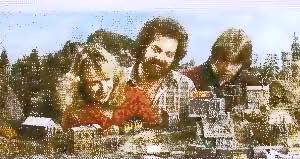  Malcolm Furlow, c. 1984 Malcolm Furlow, c. 1984
I
considered Malcolm Furlow to be the reincarnation of John Allen.
He, like John Allen, was a photographer and artist, but he had a flair for
model railways all his own, and worked in both small and large
scales
Coincidences do exist. An
advertisement for a large scale railway built by Malcolm Furlow
appeared in a 1992 Model Railroader magazine. Since I really admired
Malcolm's modeling work and the track plan was "just right", I
negotiated the move of the railway from San Diego to Rocky
Mountain House in Alberta. The full story of the renovation,
rewiring, and modernized control systems are described
HERE.
Scenery was a big issue. While the Styrofoam mountain scenery was
magnificent, the prairie scenes were pretty bare. Only 1
lonesome cactus relieved the topography. So for two years, I re-ballasted the track, built roads and a lake, planted grass,
trees, flowers, laid snow on the peaks, and built Styrofoam
scenery from the table top down to the floor. Vehicles, people, animals,
and a number of new buildings were added. A large staging yard
was added and a backdrop was commissioned for two walls of the
garage. Finally, the railway
looked "just right" too.
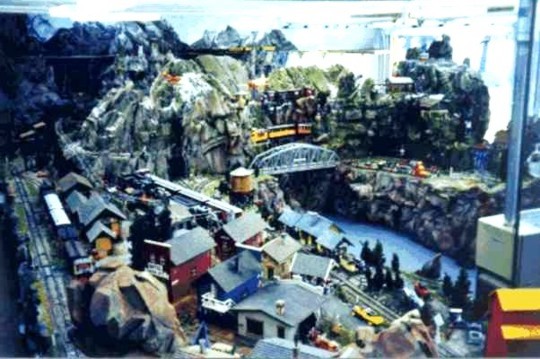
Overall view of RMH. N & P Ry. Nordegg at left, Rocky Mountain House in center foreground.
Banff Springs at right, Gorgeous Gorge Bridge at center of photo,
Sulphur
Mountain right background, and Mystic Ridge at left. Era is
around 1924. Track is LGB code 332 Gauge 1, representing 3-foot
gauge (roughly) at 1:22 (G) Scale.
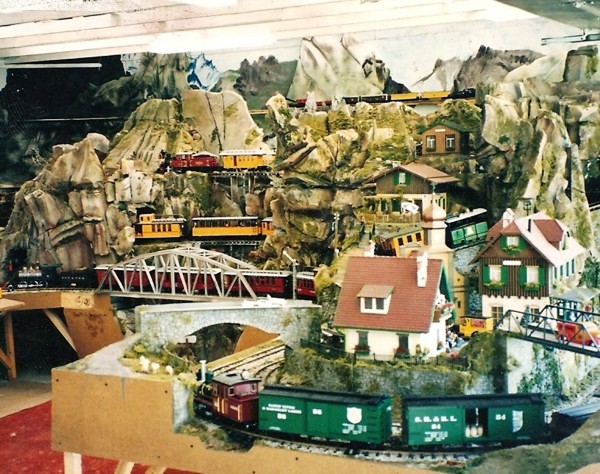
SR&RL Forney 0-4-4T #24 at Banff Springs is on the same
level as DSP&P 2-6-0 Mogul #71 on the Gorgeous Gorge Bridge, but
will pass behind it through a tunnel. D&RGW 2-8-0 Consolidation
#268 pauses the excursion train on the 2nd level to give
tourists the view of their lives. G&D 0-4-0 Porter #2, on the
3rd level, is checking the beavers gnawing on the trestle bents
at Devil's Gulch. Steam Tram cog loco #13 runs on the 35% grade
at right between levels 2 and 3. W&A 4-4-0, the "General", hauls
a load of passengers on the 4th level in the distance. It is
an O Scale train that fools the eye, giving an impression of
great distance to the mountains.
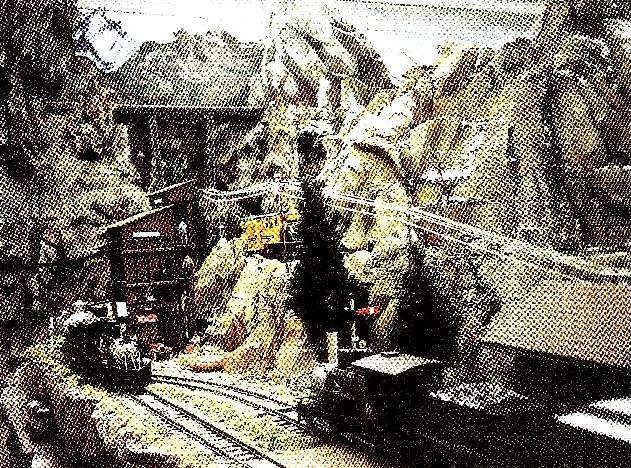 This photo appeared in LGB Telegram
Magazine
This photo appeared in LGB Telegram
Magazine
Fall 1998 on the Golden Spike
Award page 
Many more photos can be found
HERE.
 See this
story in Spring 2000 LGB Telegram. See this
story in Spring 2000 LGB Telegram.
This model railway has been sold to Stanley Riegel of Rosebud,
Alberta. Operation at the new site is
expected in 2023.
 MY
Rocky mountain house, LEAVERITE and NORTHERN RAILWAY - The south
park line in canada MY
Rocky mountain house, LEAVERITE and NORTHERN RAILWAY - The south
park line in canada
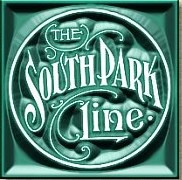 With
the indoor railway looking right and running right, there wasn't
much left to do from a modeling point of view. What to do? Well.
build another one, of course.
This time, it would be a large scale outdoor railway on a steep
side lawn beside the house. This railway would have a specific
theme, namely the Denver, South Park and Pacific Railroad around
1885. Steam engines and horse and wagons - no internal
combustion. With
the indoor railway looking right and running right, there wasn't
much left to do from a modeling point of view. What to do? Well.
build another one, of course.
This time, it would be a large scale outdoor railway on a steep
side lawn beside the house. This railway would have a specific
theme, namely the Denver, South Park and Pacific Railroad around
1885. Steam engines and horse and wagons - no internal
combustion.
We have less than a 3 month USDA "Zone 3" summer, so I didn't
want to waste time nurturing plants that might never survive. As
a result, the railway was built as a xeroscape (no plants) rock
garden using glacial erratics as the foundation for the scenery.
This led to lots of bridges, a tunnel, and simple, continuous
operation, with walk-around radio control.
Construction began in 2003 with trains running inside 3 months -
no scenery, just rocks and track. In subsequent years, buildings
evolved from crude converted birdhouses to highly detailed kit
and custom built structures.
Using a lot of the indoor techniques, adapted to the
outdoor environment, numerous mini-scenes replaced the
original low-fi buildings. A description of how all this came to
life can be found
HERE. Scenery is more rugged than the indoor railway,
and detail is not quite as fine, but the fresh air and sunshine
make up for that. Track maintenance issues are much more
realistic too, with frost heaves, deadfall, thermal
expansion, and critters to look after.
I had way more trains than track and storage was difficult.
After some mulling, I had a 1:1 scale replica of a DSP&P waycar
(caboose) built. With a transfer table for 8 trains, I could
vary the consist easily.
See the caboose story and tour this railway
HERE.
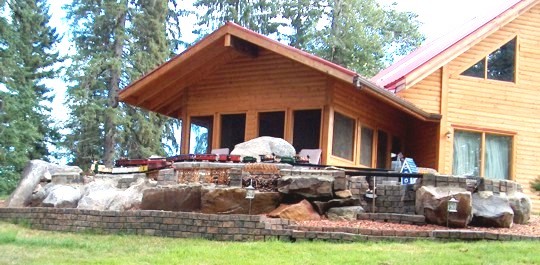
Overall view of Rocky
Mountain House, Leaverite & Northern Railway,
taken from below the Big Rock.
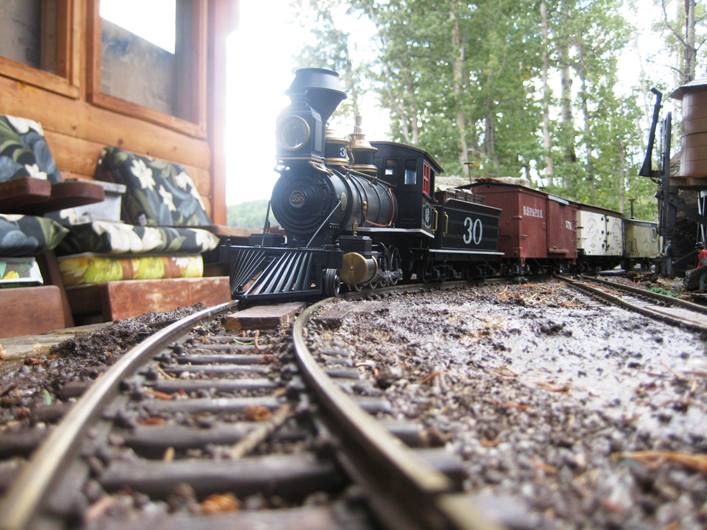
Headshot of C&S #30 and her short freight train, stopped for orders
at Glacier.
My failing eyesight forced me to offer my ranch with home and
outdoor railway for sale. The scenery modules were sold to a
neighbour and much of the rolling stock will be offered for sale on
consignment beginning in 2018. Some of my favourite large scale
kit-bashed rolling stock and the brass locomotives were kept for
display in glass fronted cabinets in my new condo -- memories of the
days when I could see well enough to call myself a model
railroader.
 MY
OFFICE RAILWAY MY
OFFICE RAILWAY
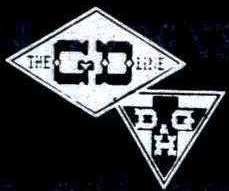 This
large scale railway was
a simple oval on top of my bookcases that encircled my
home-office. It had an automatic passing track so that two small
trains could meet and pass. The scenery was all false fronts. Track
ballast is grey carpet. Simple and basic. One train was a
kit-bashed tribute to John Allen and his Gorre and Daaphetid
Railroad. This
large scale railway was
a simple oval on top of my bookcases that encircled my
home-office. It had an automatic passing track so that two small
trains could meet and pass. The scenery was all false fronts. Track
ballast is grey carpet. Simple and basic. One train was a
kit-bashed tribute to John Allen and his Gorre and Daaphetid
Railroad.
The other was a Grizzly Flats excursion train headed
by the pretty little LGB model of "Chloe". I didn't run them much;
the sounds can drive you nuts in such a small room. But they were
a nice display in a space that would otherwise look empty.
This railway
was dismantled in 2017 and the false fronts donated to a
neighbour who has a great overhead railway running in his
machine shop.
 MY
LARGE SCALE RAILWAY MODULES MY
LARGE SCALE RAILWAY MODULES
I built three 4-foot
modules to the Del Oro standard back in 1998, using styrofoam base, backdrop,
and scenery elements. LGB track, commercial buildings, a scratch
built mine, and lots of details (animals, people, trees, bushes,
weeds) mimic what I had done on my indoor large scale railway.
These modules now live in my home-office at the new condo,
awaiting some renovation after 20 years of gathering dust.
Although they were intended to operate, they are currently
static dioramas. Oh well, they are pretty.

Display modules: Lost
Lemon Mine (left) with Brewster, an 0-2-2-0 working the ore car,
Daly Glen Tank and Station (center), Foggy Bottom Lighthouse and
Poisson Ratio's Fish Plant (right).
Click here for larger image
(1.0 Mb)
Use the View > Full Screen option to scroll across the large image
-- if you look closely near the front
door of the fish plant, you will find me, my beard, and my Great Pyranees
dog.
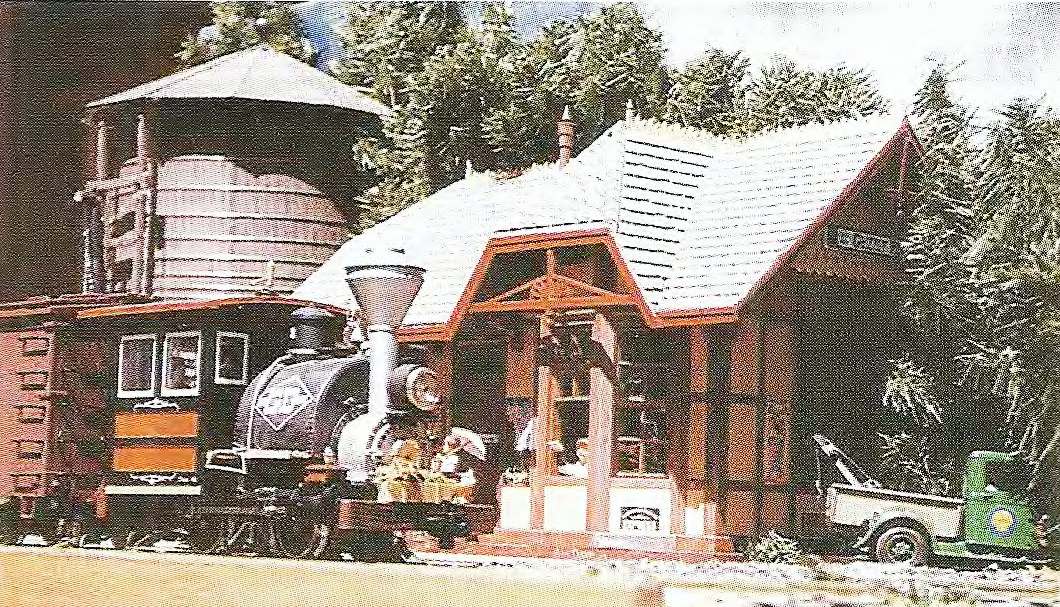
Closeup of Daly Glen Tank and Station as it appeared in the April
2000 issue of Finescale Railroader's "Module Challenge"
When I moved to the condo
from the ranch, these three modules came with me to live in my new
home-office. Twenty years after these were built, I decided to build
a ranch module using the oil derrick and Hereford cattle from the
garden railway. My eyesight had deteriorated to such a degree that
the entire module was built "by feel" and not "by eye". Lots of
animals, trees, bushes, weeds, a gravel road, track and ballast were
glued in place without a hitch.
Module #4: Oilwell, Mack 1908 AB
oil tank truck, cattle, me, my dog, my hired
hand Roy on his horse
Trigger, and an old thrasher fill the scene. See if you can spot the
bison and bull moose.
|




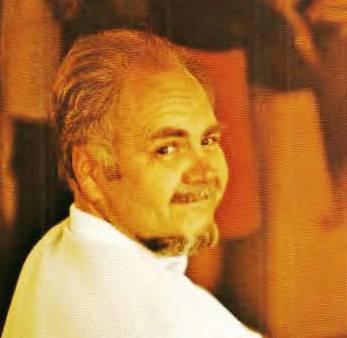
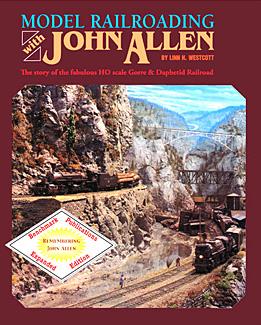 He was a
professional photographer by trade and
that skill made images of his models stand out above
all others. Aside from spectacular floor to ceiling scenery, he
pioneered many simple ideas like mirrors to extend
scenes and sound effects to represent a subway train (there was
no train, just the sounds).
He was a
professional photographer by trade and
that skill made images of his models stand out above
all others. Aside from spectacular floor to ceiling scenery, he
pioneered many simple ideas like mirrors to extend
scenes and sound effects to represent a subway train (there was
no train, just the sounds). One
of John's photos vividly embedded itself in my memory, shown at the
left. This single image influences every one of my kit-bashing
projects 50+ years
later.
One
of John's photos vividly embedded itself in my memory, shown at the
left. This single image influences every one of my kit-bashing
projects 50+ years
later.




 This photo appeared in LGB Telegram
Magazine
This photo appeared in LGB Telegram
Magazine


 This
large scale railway was
a simple oval on top of my bookcases that encircled my
home-office. It had an automatic passing track so that two small
trains could meet and pass. The scenery was all false fronts. Track
ballast is grey carpet. Simple and basic. One train was a
kit-bashed tribute to John Allen and his Gorre and Daaphetid
Railroad.
This
large scale railway was
a simple oval on top of my bookcases that encircled my
home-office. It had an automatic passing track so that two small
trains could meet and pass. The scenery was all false fronts. Track
ballast is grey carpet. Simple and basic. One train was a
kit-bashed tribute to John Allen and his Gorre and Daaphetid
Railroad. 
